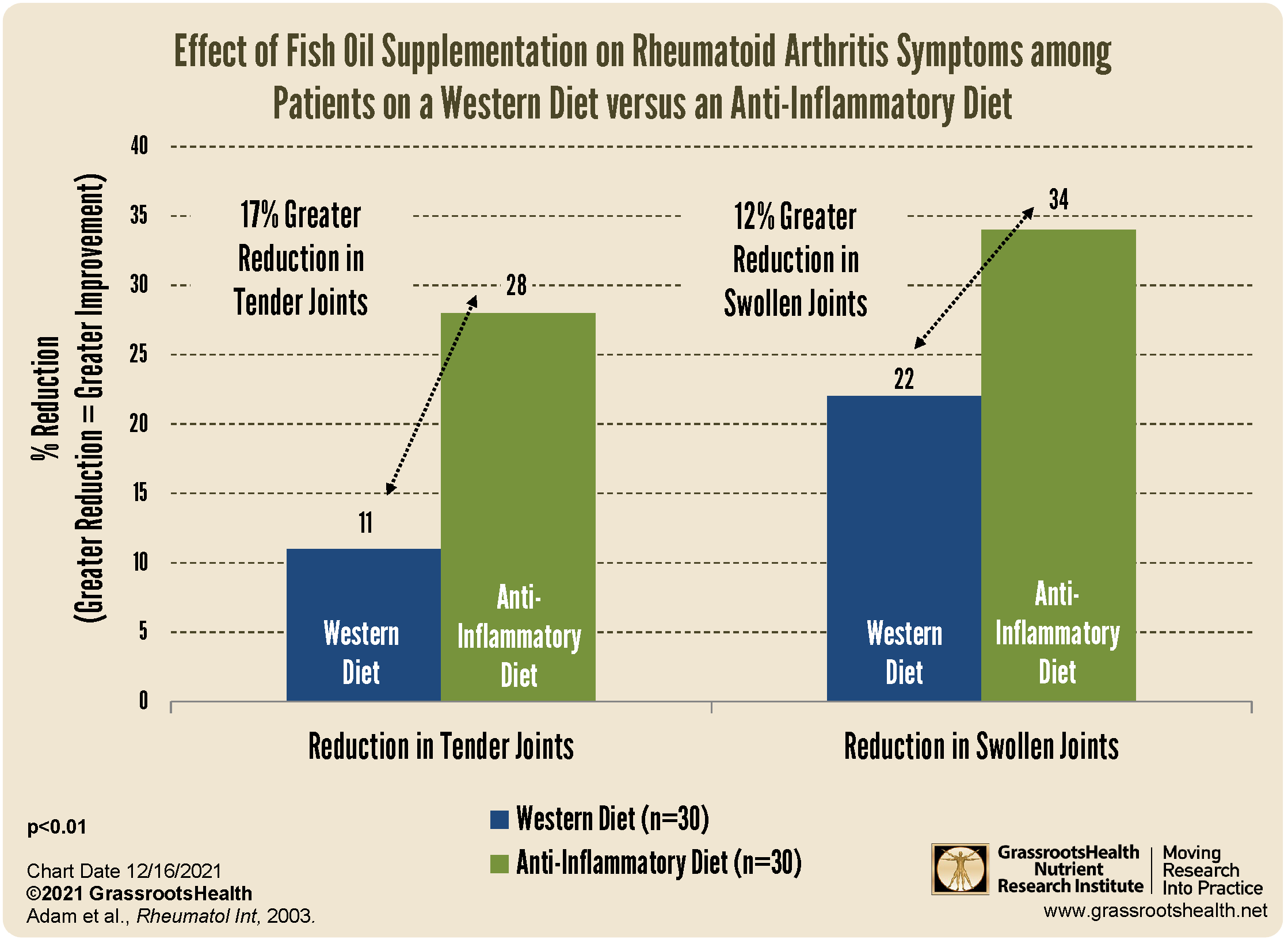Published on May 31, 2022
Symptoms of RA and other inflammatory diseases improved by decreasing pro-inflammatory fatty acids and increasing anti-inflammatory fatty acids through diet and supplementation
Key Points
- Rheumatoid Arthritis (RA) is an autoimmune disease presenting with pain and inflammation in the joints
- Omega-3 fatty acids (such as EPA) have anti-inflammatory effects, while omega-6 fatty acids (such as AA) can be pro-inflammatory
- A study on RA patients showed that a diet low in AA and supplemented with fish oils (increasing EPA) resulted in the greatest, significant improvements in RA symptoms
- Lowering the AA:EPA Ratio can be one way to help manage inflammation and improve symptoms of chronic, inflammatory diseases

Omega-3 and omega-6 fatty acids are two types of “essential” fatty acids that must be obtained through the diet. Eicosapentaenoic acid (EPA) and eocosahexaenoic acid (DHA) are the two main omega-3 fatty acids, while the most common omega-6 fatty acid is linoleic acid (LA), which is converted into longer omega-6 fats such as arachidonic acid (AA).
Omega-3 and omega-6 fatty acids work together to directly regulate inflammation, immune function, and pain. Omega-6s (such as AA) are pro-inflammatory, essential for initiating and sustaining the inflammatory response – a physiologic function necessary for healing from injuries and infection. Omega-3s (such as DHA and EPA) are anti-inflammatory and promote the resolution of the inflammatory process. The Standard American Diet tends to provide less than 150 mg/day of EPA and DHA, with the intake of linoleic acid at around 7% of energy. This can lead to an abundance of pro-inflammatory omega-6s in the cell membranes, and in turn, increases the risk of inflammation and chronic conditions and diseases related to inflammation.
Study Investigates Anti-Inflammatory Diet and Omega-3 Supplementation for Rheumatoid Arthritis Patients
Rheumatoid Arthritis (RA) is an autoimmune disease that causes inflammation and pain in the joints. RA can affect other organs in the body, increasing the risk of diseases such as cardiovascular disease, gastrointestinal disorders, infections, osteoporosis and depression.
Both vitamin D and omega-3s have been shown to benefit individuals with chronic, autoimmune diseases such as RA. A recent analysis using VITAL trial data recently reported a 25-30% decreased incidence of autoimmune diseases, including RA, among participants taking vitamin D and/or omega-3s vs only placebos. This effect may likely be due to the anti-inflammatory actions of vitamin D and omega-3s within the body.
Another study by Adam et al. compared the effects of an anti-inflammatory diet, fish oil supplementation, and the combination of both for patients with RA. 68 patients were divided into two groups:
- Group 1 followed a western diet for 8 months
- Group 2 followed an anti-inflammatory, modified lacto-vegetarian diet for 8 months; this diet provided less than 90 mg/day of pro-inflammatory AA
Both groups were also given either fish oil capsules (30 mg/kg of body weight) or placebo for 3 months at a time. RA symptoms and blood markers for inflammation and fatty acids were measured and tracked.
What did the study find?
60 patients were included in the analysis after the 8 month study. Patients on the anti-inflammatory diet had an AA intake of approximately 30% of the amount consumed in the western diet group. Blood work showed a significant correlation between AA intake and the percent of AA in the red blood cell membranes, resulting in a significantly lower percent of AA in the blood for those on the anti-inflammatory diet.
Among those supplementing with fish oils, EPA (an anti-inflammatory fatty acid found in fatty fish) levels increased by 244% in the anti-inflammatory diet group compared to 217% in the western diet group. The anti-inflammatory diet group also saw a decrease in C-Reactive Protein (CRP) levels with fish oil supplementation, while the western diet group did not.
In terms of symptoms, the anti-inflammatory diet group saw improvements in joint swelling and tenderness, with and without the addition of fish oil supplements. Adding fish oil supplements significantly reduced the number of tender and swollen joints in both groups, by
- 28% and 34% in the anti-inflammatory diet group
- 11% and 22% in the western diet group
Overall effects on joint symptoms in each group were as follows:
- no improvement in the Western Diet group without supplements; a 17% overall improvement when fish oil supplements were added
- a 14% improvement with the anti-inflammatory diet alone, and a 31% overall improvement with an anti-inflammatory diet plus fish oil supplements
This study indicates that lower intake of AA and/or increased intake of EPA may lead to improvement in RA, with the greatest benefit seen with a combination of lower AA and higher EPA.
Using the AA:EPA Ratio to Measure Inflammation Levels
The AA:EPA Ratio test measures the ratio of the amount of pro-inflammatory AA and anti-inflammatory EPA in the red blood cells, and can be an indication of the amount of cellular inflammation in the body. Desirable ranges for health are generally between 2.5 and 11, however, some experts recommend an even lower AA:EPA Ratio of 1 to 3 for the resolution of cellular inflammation. Measuring the ratio can help individuals take more specific steps to achieve an ideal ratio and lower overall inflammation levels, mainly by increasing omega-3s (EPA and DHA) intake and decreasing pro-inflammatory omega-6 intake (such as AA).
When ordering the Omega-3 Index test through GrassrootsHealth, the AA:EPA Ratio test can be added on, and comes with the Omega-6:Omega-3 Ratio test. The Omega-6:Omega-3 Ratio test is another way to measure the amount of bad fats to healthy fats in the body. Both tests can provide guidance to specific dietary changes that could support improvements in chronic inflammation and disease.
Learn more about the importance of measuring these ratios and how the AA:EPA Ratio test specifically is an important predictor of our future health.
Add the AA:EPA Ratio to Your Custom Home Test Kit
 Having and maintaining healthy vitamin D, omega-3s, and other nutrient levels can help improve your health now and for your future. Choose which to measure, such as your vitamin D, omega-3s with the AA:EPA Ratio, and essential minerals including magnesium and zinc, by creating your custom home test kit today. Take steps to improve the status of each of these measurements to benefit your overall health. With measurement you can then determine how much is needed and steps to achieve your goals. You can also track your own intakes, symptoms and results to see what works best for YOU.
Having and maintaining healthy vitamin D, omega-3s, and other nutrient levels can help improve your health now and for your future. Choose which to measure, such as your vitamin D, omega-3s with the AA:EPA Ratio, and essential minerals including magnesium and zinc, by creating your custom home test kit today. Take steps to improve the status of each of these measurements to benefit your overall health. With measurement you can then determine how much is needed and steps to achieve your goals. You can also track your own intakes, symptoms and results to see what works best for YOU.
Enroll in D*action and Test Your Levels Today!






